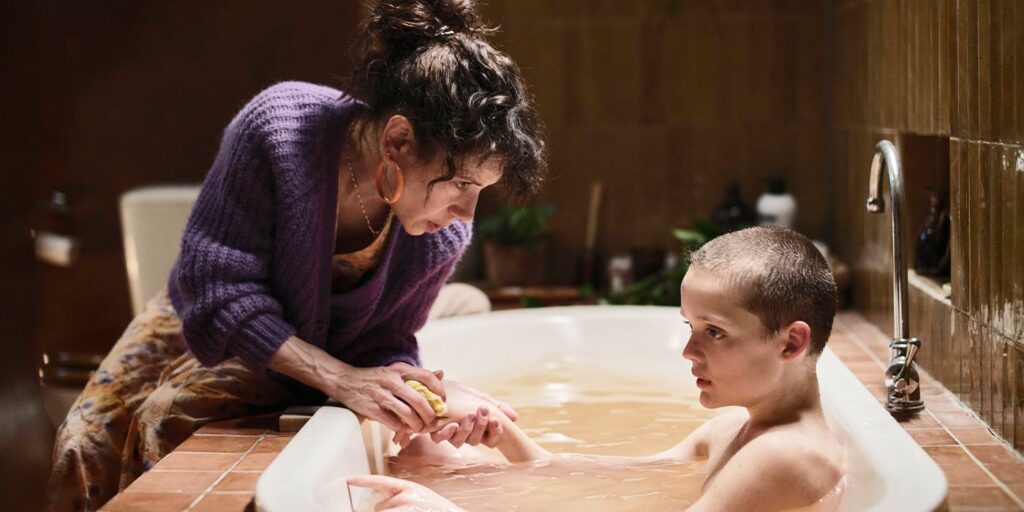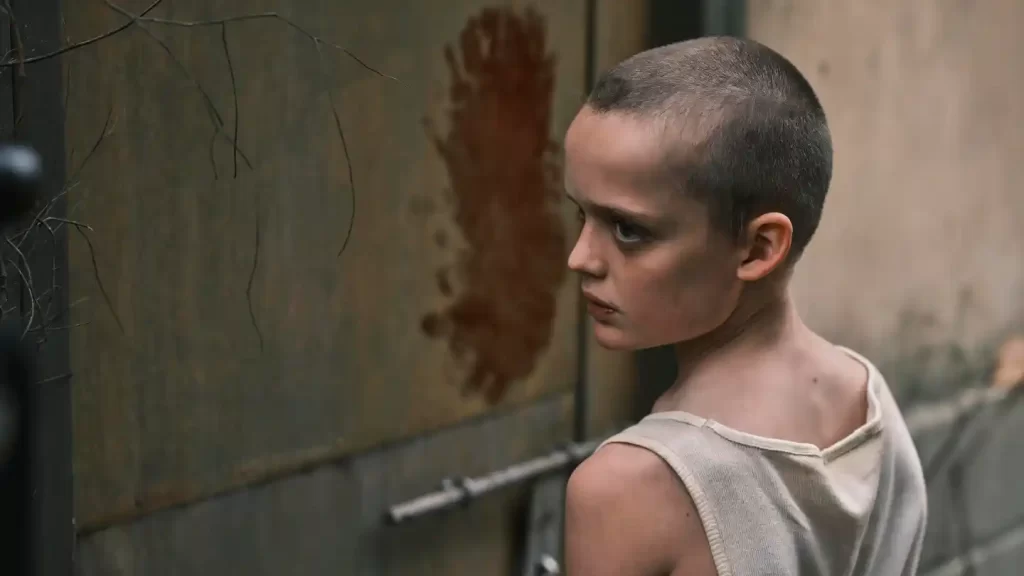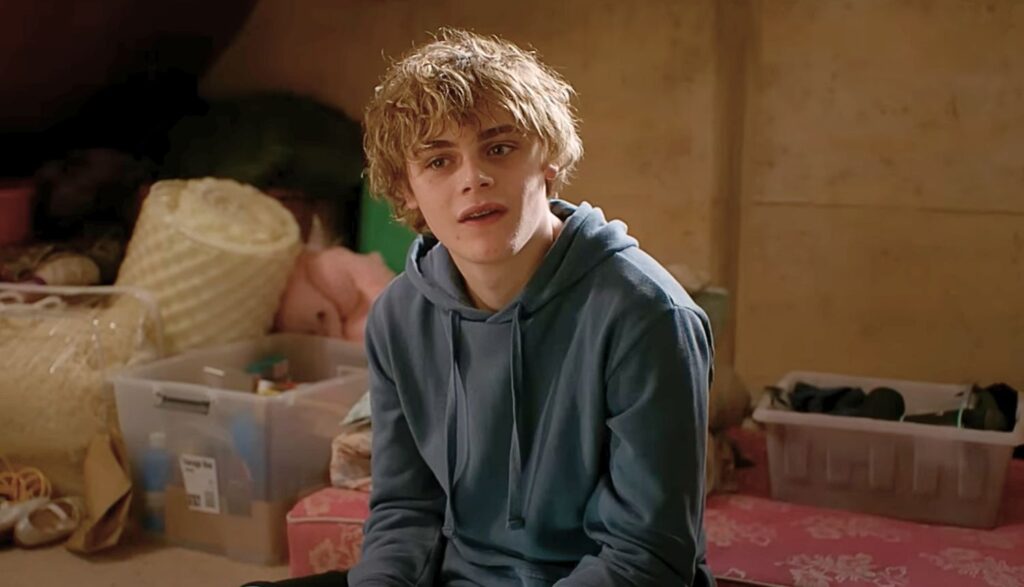
For two guys who cut their teeth making YouTube videos, Danny and Michael Philippou are curiously retro when it comes to horror iconography. Their first feature, the indie hit Talk to Me, fashioned its inciting instrument as a large ceramic hand, one that facilitated spiritual possession through the nigh-quaint process of physical connection. Their follow-up, Bring Her Back, opens with grainy VHS footage depicting an enigmatic ritual whose significance won’t be established until some time later. The movie features a fair number of scares, but the biggest jolt for this Xennial was remembering just how frustrating it was to futz with the tracking setting on a VCR.
This doesn’t mean the Philippous are classicists. But they aren’t exactly modernists either; their skills and shortcomings could easily belong in any era of horror filmmaking. Bring Her Back confirms their talents as purveyors of mood, taking place in an unsettling surreality where the vibes are always off and your danger sensor is constantly on. As a piece of evocative atmosphere, it’s quite creepy. As a work of dramatic storytelling, it’s stillborn.

One thing it isn’t, at least, is compromised. Depending on your tastes, the Philippous are either boldly transgressive or coldly sadistic, but nobody could accuse them of kidding around. The plot of Bring Her Back grinds into gear when two teenagers, 17-year-old Andy (Billy Barratt) and his mostly blind younger sister, Piper (Sora Wong, in her screen debut), find their father’s bloody, lifeless body on their bathroom floor. It’s far from the most disturbing tableau they’ll perceive over the course of the movie, which is stocked with all manner of ghastly images: urine poured onto faces, bodies drowned in puddles, corpses stuffed into freezers. But the scariest sight of all? That would be Sally Hawkins.
A venerable English actress with multiple Oscar nominations to her name (The Shape of Water, Blue Jasmine), Hawkins is typically associated with prestige rather than terror. And her character here, a foster mother named Laura who shelters Andy and Piper after that horrific discovery, is outwardly sweet and homey. With her tangled hair and her knitted cardigans, Laura presents as cheerfully absent-minded—a bit odd, maybe, but still a harbor of warmth and safety. And yet… why is she so cagey about her other foster son, a mute boy called Oliver (Jonah Wren Phillips)? Why is she so insistent that Andy kiss his dead dad on the lips at his funeral? Why does she keep venturing to a locked garden shed, away from prying eyes?

As the plot of Bring Her Back progresses, these questions become less mysterious than tedious. The Philippous may have a strong grasp of tone, but they are less assured when it comes to structure and pacing. If the movie succeeds in keeping you on edge, it does so more by creating a perverse form of anticipation—you are always wondering what nightmarish thing you might see next—than by developing genuine suspense.
That said, the Philippous stage their grotesqueries with impressive conviction, even if their command of metaphor is clumsy. (Is this yet another horror movie about the persistence of trauma? Eh, not really, which doesn’t mean it’s about anything else either.) A sequence in which a deranged Oliver gnaws on a knife blade is undeniably potent, while other moments of violence—a cat that wanders into unloving arms, a vicious punch delivered to a sleeping child—will rattle you with their sheer nastiness.

The Philippous do exhibit the decency (or perhaps the savagery) to dilute their venom with a measure of tenderness. Though she serves as both the driver of the film’s narrative and the center of its intrigue, Laura is primarily a creature of grief, having recently lost her own daughter. Yet to the extent Bring Her Back carries any emotional resonance, it derives from the sibling relationship between Andy and Piper. Their bond isn’t always harmonious—he occasionally chafes at his caretaking duties, while she doubts his honesty—but they exhibit a vocal and gestural affection that feels true to life, as in how they’ve selected the word “grapefruit” as a coded signal for truth-telling. A late shot of Piper listening to an aircraft taking flight—calling back to Andy’s earlier insistence that when you die, “you just take a plane”—is striking in its gentleness.

In theory, Bring Her Back tests the strength of their humanity by thrusting it into a crucible of horror. But the screenplay, which Danny Philippou wrote with Bill Hinzman, is too blurry and shoddy to hold your attention. The problem isn’t that it makes no sense, because movies like this aren’t really supposed to make sense. It’s that the way it makes no sense… doesn’t make sense. The mythology, involving demonic rites and chalky white outlines, is woefully vague, with scattered bits of information that never cohere and random elements (a shower flashback, a car’s mirror) that lack purpose. And the craft is too jagged, with shaky camerawork and clumsy editing, to deepen the characters. (Piper’s disability recalls Bryce Dallas Howard in The Village, but the Philippous’ choppy visual style is a far cry from the graceful blocking and framing of M. Night Shyamalan.) The result is that, as the film attempts to ratchet up its intensity, it instead keeps you at a distance.
Except, that is, for Hawkins, who can’t help but hypnotize you with her feral commitment. It may not be a performance of great depth, but it’s properly scaled to the material, eschewing nuance for primal anguish. Bring Her Back is too sloppy to be fully engrossing, but when it settles on Hawkins’ racked face, it demonstrates that no supernatural force is more powerful—or more dangerous—than a mother’s love.
Grade: C+
Jeremy Beck is the editor-in-chief of MovieManifesto. He watches more movies and television than he probably should.
